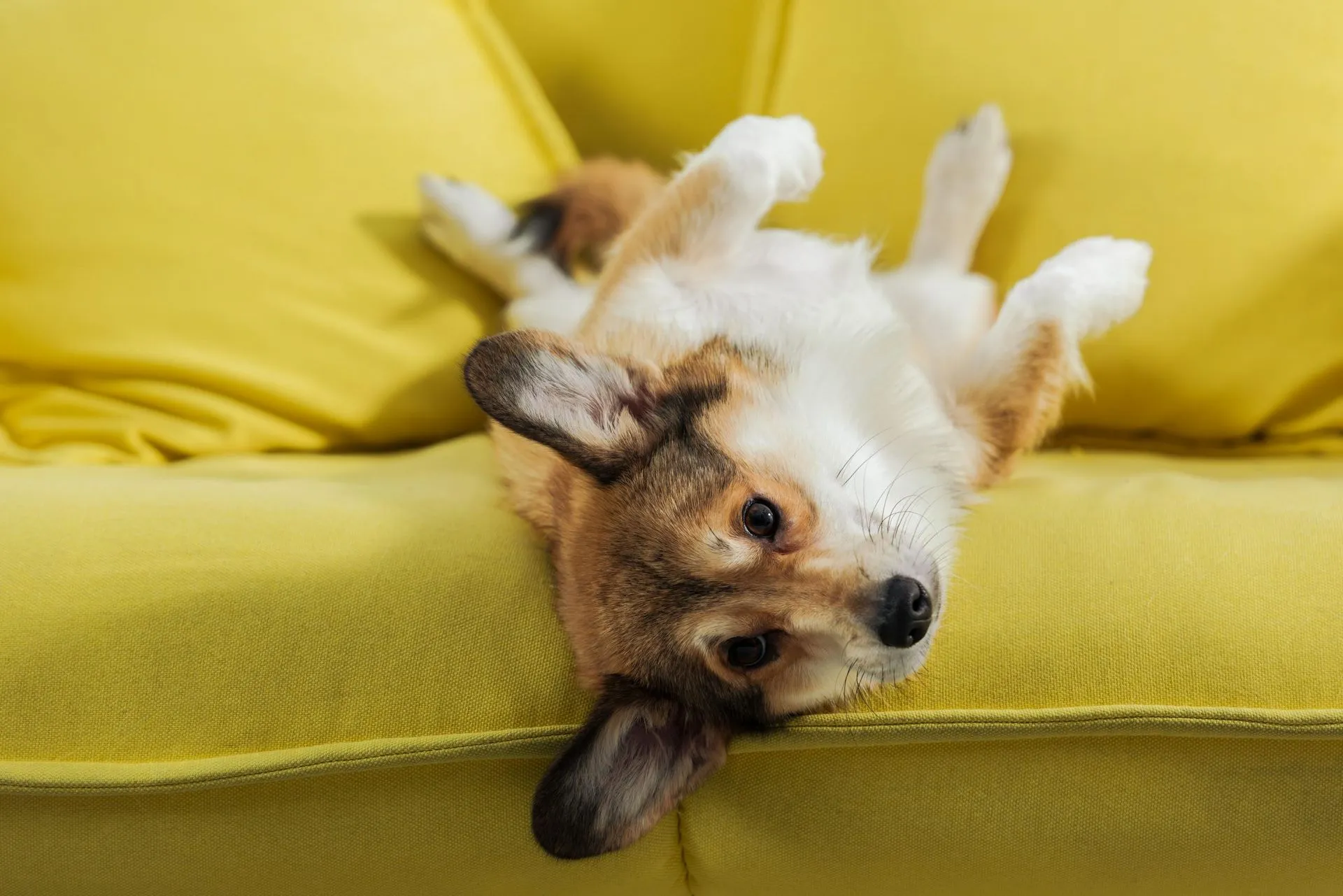As dog owners, we cherish the companionship our furry friends bring into our lives, often welcoming them into every corner of our homes. For many, this includes sharing the comfort of the sofa – a cozy spot perfect for snuggles, especially on a chilly evening by the fire. However, the privilege of sofa access should ideally be by invitation only, a clear boundary that maintains harmony in a shared living space. This distinction is crucial, as not every dog owner or guest appreciates a muddy paw print or an uninvited canine lap warmer. The challenge of managing a dog that views the couch as their personal bed is a common one, as highlighted by a reader from Cornwall who reached out with a familiar dilemma:
‘Although I adore my two chocolate Labradors, I’ve made a rod for my own back by letting them up on the sofa. How do I persuade them that the comfy bed they have on the floor beside it is a better option?’
This isn’t just about curbing unwanted behavior; it’s about refining a routine and setting clear expectations. Unlike more overt issues such as jumping up on people or barking excessively, teaching a dog to stay off the sofa requires a subtle yet consistent approach. It’s about establishing a framework of understanding and respect, a principle central to effective dog training. By implementing a few clear ground rules and consistent training, you can successfully teach your beloved canine companion appropriate lounging etiquette and achieve a peaceful coexistence. If you’re looking for broader guidance, here’s how to get a dog to stay off furniture effectively.
Foundational Steps to Keep Your Dog Off the Sofa
Sharing your home with dogs is a joy, but it’s essential to set clear boundaries for mutual respect and comfort. Here are five practical steps derived from decades of experience to help you train your dog to stay off the sofa.
1. Establish Designated Resting Spots (Dog Beds)
One of the most effective strategies to keep your dog off the sofa is to provide them with their own inviting, comfortable, and consistent resting spots. I ensure my indoor dogs – which include a Border terrier, a Bavarian mountain hound, and a retired working Labrador – have a dedicated place in every area they are permitted to be in. These designated spots allow them to settle, relax, and feel secure.
For example, when I move into the lounge, I bring their beds with me (depending on how many we have available), call them to the area, and instruct them to go “in” their beds. This routine teaches them that their bed is their personal space within that environment. To prevent your dog from leaving their designated spot and jumping on the sofa for attention, I primarily use two commands: “leave,” accompanied by a hand direction, and pointing to their bed while saying “in.” The “leave” command is vital for teaching them to disengage from tempting objects or areas. When they move towards their bed on command, reward them immediately with praise or a small treat. This positive reinforcement solidifies the association between their bed and a desirable outcome, making it a “good place to be.” This strategy is key to how to teach a dog to stay off couch successfully.
2. Reinforce Basic Commands if They Don’t Listen
If your dog consistently fails to respond to your commands, it’s a clear indication that they haven’t fully grasped the instructions. In such cases, the solution is straightforward: revisit and reinforce their foundational training. This isn’t a setback but an opportunity to strengthen their understanding and obedience.
I typically guide my clients through a specific routine once their dogs enter the lounge. The owners should hold their dog’s bed (or beds), ask the dog to sit, and then place the bed(s) in the chosen area where they want their dog to relax. Next, they call the dog to their individual bed, rewarding each one with kibble for their good behavior. This repeated positive association ensures that the dog recognizes its bed as a positive and comfortable place, regardless of its location. This method is crucial when you need to train dog to not jump on couch consistently.
 Adorable Cocker Spaniel puppy napping peacefully in a soft wicker dog bed, demonstrating a dog's designated resting spot
Adorable Cocker Spaniel puppy napping peacefully in a soft wicker dog bed, demonstrating a dog's designated resting spot
This principle extends beyond your home. When traveling or visiting friends, bringing a familiar item – such as their bed or even a towel they’ve used – can serve as their designated “place.” I once stayed at a hotel with my Labrador, Nell, and hadn’t brought her bed. I used the fluffy shower mat, placed it in the corner, told her to lie on it, and she slept soundly all night. This ability to establish a consistent space, even in unfamiliar environments, is incredibly advantageous, providing your dog with comfort and stability while maintaining your household rules wherever you go. My brother and sister-in-law, for instance, always bring their liver Cocker Spaniel, Purdey’s, bed into the kitchen upon arrival, ensuring she’s calm and settled, making everyone happy.
3. Consistency is Key: Avoid Mixed Signals
Allowing your dog to get on the sofa inconsistently will create confusion and make the training process significantly harder. If a dog is sometimes allowed on the sofa, they will naturally expect to be there whenever they please, rather than waiting for an explicit invitation. This inconsistency undermines your authority and the effectiveness of your commands.
In our home, this dynamic is evident. When my wife and I enter the lounge in the evening, I usually sit first. Our dogs will look at me, respecting my space and waiting for an invitation. However, when my wife comes in, they often eagerly jump onto her, demonstrating a lesser degree of respect for her boundaries compared to mine. This difference in behavior on the sofa often extends to other aspects of their lives; for instance, they may not behave with the same level of discipline and good manners during walks with her as they do with me. This highlights a common issue of dog won t stay off the couch due to inconsistent enforcement of rules. Consistent enforcement of rules by all family members is paramount for effective training and overall canine good behavior.
4. Practice Makes Perfect: A Consistent Regime
If you’ve previously permitted your dog on the sofa but have now decided to change this rule—perhaps for hygiene, to host guests, or simply to enjoy some peaceful time—be prepared to put in the work. As with any behavioral modification, regular practice of the new regime is essential to achieve the desired results.
In an ideal scenario, if your dog is already on the sofa, you would point to their bed and calmly say, “Bertie, in!” What if Bertie hesitates or refuses? As discussed, it’s crucial that your dog knows their name and understands that following the command leads to a positive outcome and a rewarding place. This means reinforcing the “in” command with treats and praise when they comply. Make their bed an attractive alternative to the sofa by associating it with comfort and positive experiences.
 Attentive Golden Retriever dog looking focused, demonstrating readiness for positive reinforcement training
Attentive Golden Retriever dog looking focused, demonstrating readiness for positive reinforcement training
Begin practicing in short, focused sessions. Lure your dog off the sofa with a treat, direct them to their bed, and reward them generously when they settle. Gradually increase the duration they spend in their bed before receiving a reward. The key is to make their bed the most appealing option. Your consistency and patience during these practice sessions will gradually reshape their habits and expectations, teaching them that their bed is the preferred spot.
5. Recognize When Your Dog Isn’t Ready
There will be times when your dog, or dogs, become overly excited, jumping in and out of their beds and running back and forth. This heightened state of arousal is a clear indication that they are not yet ready to manage their behavior in a stimulating environment, especially when people, food, or drink are present. Pushing them to comply when they are over-excited will likely lead to frustration for both you and your dog.
The most effective way to address this is to restart the training process in a calm, controlled manner. Begin by guiding your dog back to their bed. Once they are settled, place a food reward on the floor immediately next to their bed. This visible reward gives them a strong, positive reason to sit and observe the kibble. Every so often, walk past their bed, lean down, and reward them with a piece of kibble. The strategic placement of the reward ensures your dog can clearly see it, motivating them to stay in their designated spot. Over time, they will learn to ignore distractions, understanding that staying calmly in their bed will lead to that anticipated reward. This technique is particularly helpful for addressing how to stop puppy jumping on couch behavior before it becomes ingrained.
As your dog becomes accustomed to this routine, typically after about a week or so, they will happily go into their bed and remain there for extended periods—whether you’re watching a film or simply relaxing in the lounge. They learn that a reward, be it praise, an ear scratch, or a piece of kibble, will consistently come their way. This sustained positive reinforcement fosters a calm, cooperative companion who understands and respects the boundaries you’ve set, ensuring a harmonious home for everyone.
Conclusion
Teaching your dog to stay off the sofa is a journey that requires patience, consistency, and clear communication. By establishing designated resting spots, reinforcing basic commands, maintaining unwavering consistency, engaging in regular practice, and recognizing when your dog needs a calmer environment, you can successfully guide your furry friend toward appropriate behavior. The goal is not just to keep them off the furniture, but to build a stronger bond based on mutual understanding and respect. Remember, a well-trained dog is a happier dog, and a harmonious home benefits everyone.
For more detailed advice on positive, reward-based, and proven training methods, including one-to-one sessions, residential training, or five-star dog-boarding at BGHQ, contact Ledbury Lodge Kennels at 01531 670960 or visit www.ledburylodgekennels.co.uk. You can also explore a free seven-day trial of the Gundog app, available at www.gundog.app/trial, which offers comprehensive guidance for training your canine companion.
